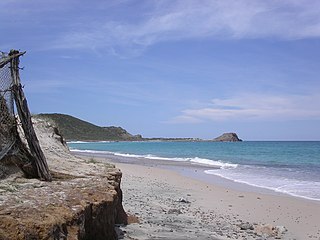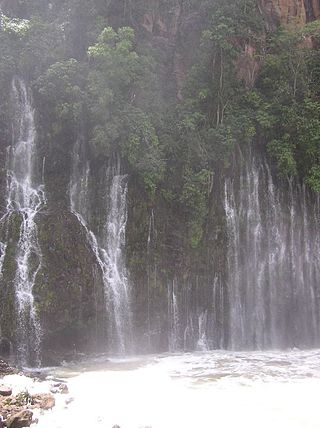Related Research Articles

Environmental protection is the practice of protecting the natural environment by individuals, groups and governments. Its objectives are to conserve natural resources and the existing natural environment and, where it is possible, to repair damage and reverse trends.

The Cumbres de Majalca National Park is a national park in the Mexican state of Chihuahua located 88 km northwest of the city of Chihuahua. The park showcases extraordinary rock formations that have been shaped by wind and water erosion. The park was created by presidential decree in 1939 encompassing 4,772 hectares to protect the endemic flora and fauna. The park is characterized by pine and oak forest. It is also one of the few areas in Mexico that are inhabited by black bear.

Dzibilchaltún is a Maya archaeological site in the Mexican state of Yucatán, approximately 10 miles (16 km) north of state capital of Mérida.
Piedra Volada Falls is a 453-meter tall plunge rainy season waterfall in the Barranca Candameña of the Sierra Madre Occidental range in Chihuahua, Mexico.

Desierto de los LeonesNational Park is located entirely within the limits of the Federal District; it stretches between Cuajimalpa and Álvaro Obregón boroughs. It is located in the Sierra de las Cruces mountain range west of the city center with an area of 1,867 hectares, representing fifteen percent of the entire Valley of Mexico. The term Desierto (‘desert’) is used in this context in the archaic sense of “wild, sparsely populated area” rather than in reference to an arid environment. Leones (‘Lions’) refers not to the big cats but rather to the original landlord's surname.

There are currently 182 Protected Natural Areas in Mexico, covering 25.4 million hectares in total. They are protected and administered by the National Commission of Protected Natural Areas, a federal agency. CONANP administers:
Mexico's natural monuments are protected natural areas.
Mexico's Natural resources protection areas are nine federally-recognized protected areas in Mexico that are administrated by the federal National Commission of Protected Natural Areas.
Mexican Flora and Fauna Protection Areas comprise 29 protected natural areas of Mexico administrated by the National Commission of Protected Natural Areas, an agency of the federal government.

Iztaccíhuatl–Popocatépetl National Park, also known as Izta-Popo Zoquiapan National Park, is a national park in Mexico on the border of the states of México, Puebla, and Morelos. The park protects 39,819.08 hectares, surrounding Mexico's second- and third-highest peaks, the Popocatépetl and Iztaccíhuatl volcanoes as well as the area of the Hacienda de Zoquiapán, and its annexed areas (anexas) of Zoquiapan, Ixtlahuacán, and the Frío de Juárez River.
The Secretariat of Environment and Natural Resources is Mexico's environment ministry. Its head, the Secretary of the Environment and Natural Resources, is a member of the federal executive cabinet and is appointed by the President of Mexico. In September 2020, President Andrés Manuel López Obrador appointed María Luisa Albores González as Secretary of the Environment and Natural Resources, the third person to occupy the post since López Obrador became President less than two years earlier in December 2018.

The Comisión Nacional para el Conocimiento y Uso de la Biodiversidad is a permanent inter-ministerial commission of the Federal Mexican government, created in 1992. It has the primary purpose of coordinating, supporting and executing activities and projects designed to foment understanding of biodiversity within Mexico and the surrounding region. As a governmental agency, CONABIO produces and collates biodiversity data and assessments across Mexico's varied ecosystems. It also either administers or guides a range of biological conservation and sustainability projects with the intention of securing benefits to Mexican society as a whole.

Sierra de Quila, officially the Sierra de Quila Flora and Fauna Protection Area, is a Mexican Flora and Fauna Protection Area in the state of Jalisco, Mexico. It has an area of 15,193 hectares, and is located within six municipalities: San Martín de Hidalgo, Tecolotlán, Cocula, Atengo, Tenamaxtlán, and Ameca.

El Tepeyac National Park is one of a number of federally recognized national parks in Mexico that are protected natural areas and administered by the federal National Commission of Protected Natural Areas (CONANP), a subsidiary of SEMARNAT. It is one of the few green areas located north of the Mexico City suburbs. 95% of its territory is located in Gustavo A. Madero, D.F. Borough and 5% in the municipality of Tlalnepantla de Baz.

Cabo Pulmo National Park is a national marine park on the east coast of Mexico's Baja California Peninsula, spanning the distance between Pulmo Point and Los Frailes Cape, approximately 100 kilometres (62 mi) north of Cabo San Lucas in the Gulf of California. Bahía Pulmo is home to the oldest of only three coral reefs on the west coast of North America. Cabo Pulmo is estimated to be 20,000 years old. The 27 square mile national park is home to 11 different species of coral. It is the northernmost coral reef in the eastern Pacific Ocean.

Barranca del Cupatitzio National Park is a national park in the Mexican state of Michoacán, centered around the headwaters of the Cupatitzio River. The river emerges from an underground spring, carving a small ravine as the water begins to flow. The park is known for its abundant streams and springs, many of which cascade down the sides of the ravine to form small waterfalls.

Sierra de Órganos National Park is a national park in Mexico, located in the northwest corner of the municipality of Sombrerete in the state of Zacatecas, near the border with Durango. The park is known for its diverse aridland ecosystem and towering rock formations of the Sierra Madre Occidental, which are reminiscent of organ pipe cacti or the pipes of the musical instrument, from which the park takes its name.

Bahía de Loreto National Park is a national park on the east coast of the Baja California Peninsula in Mexico, about 203 kilometres (126 mi) north of the city of La Paz in the state of Baja California Sur. The park protects 2,065.81 square kilometres (797.61 sq mi) of relatively pristine marine ecosystem in the central Sea of Cortez, including five large uninhabited islands and many smaller islets in Loreto Bay. It is known for its great variety of coastal environments, such as sandy beaches, sea cliffs, submarine canyons, and marine terraces, and is home to an exceptionally high biological diversity, especially of marine mammals.

The Mexico-United States international park, also known as El Carmen Big Bend Complex, is a proposed transboundary protected area straddling the part of the U.S.–Mexico boundary delineated by the Rio Grande. Proposed by U.S. President Franklin Delano Roosevelt to Mexican President Manuel Ávila Camacho in 1944, the goal remains unfulfilled. The proposed bi-national park is along a 268 mile stretch of the river, which is approximately 14% of the border between Mexico and the United States. It consists of 3 protected areas and parks in Texas and 4 in Mexico, which include Big Bend National Park, the Maderas del Carmen, Ocampo, and Cañón de Santa Elena flora and fauna protection areas, Monumento Río Bravo del Norte, Big Bend Ranch State Park, and Black Gap Management Wildlife Area. As it is a region of protected areas and parks, the El Carmen Big Bend Complex area is the habitat for many types of birds, mammals, plants, and insects. Due to this, the area is a prime spot for ecotourism for both the United States and Mexico along the border. Recent issues of increased border security and environmental concerns have emphasized the need for reopening the discussion, which is currently led by organizations such as the National Park Service in Big Bend National Park, the Sierra Club, and Rotary International.
References
- ↑ National Commission of Protected Natural Areas Archived 2011-08-26 at the Wayback Machine , retrieved 6 February 2012